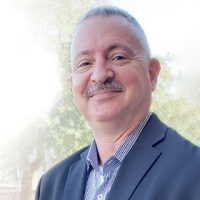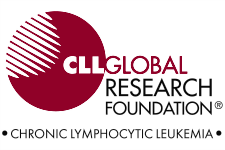Expert Panel:

Dr. William Wierda, President & CEO, CLL Global Research Foundation

Jeff Folloder, Moderator and CLL patient advocate
Our recent CLL Global Research Foundation virtual town hall featured CLL Global President, Dr. William Wierda, and Dr. Erin Parry, an Investigator of Hematologic Neoplasia at Dana-Farber Cancer Institute. CLL patient advocate Jeff Folloder moderated the event. Watch the full webinar.
Transcript
Jeff Folloder:
There is a lot that has been happening in the world of CLL. I marvel at how much has happened since the time I started almost 15 years ago. So much good stuff is happening, and so much is happening so fast. Now that we’ve met our guests, let’s move on to learning about the latest research and treatment developments. Dr. Wierda, what highlights would you like to share with our audience from the recent big scientific meetings?
Dr. William Wierda:
Great. Thanks, Jeff. Yes, I’d like to give a little bit of a summary and an update to patients and colleagues who join us on these town halls in terms of what’s been happening new in CLL. We usually learn about data early through meetings and presentations at meetings, and then those works usually get published after a process of reviewing. So, what I wanted to do was go over two meetings and just highlight what was presented at those two recent meetings, which have happened since our last town hall.
The first one is ASCO 2024. That’s a meeting that occurs typically in June in Chicago. That’s the American Society of Clinical Oncology. There’s one presentation from that meeting related to CLL that I’m going to highlight and then the European Hematology Association, which is a meeting also that occurs around June every year. This is obviously in Europe. This year it was in Madrid.
I have several abstracts that I wanted to touch on that relate to that meeting, and we can talk about the data in a little bit more detail in the question-and-answer session. But, again, I just wanted to give a brief highlight. So, the ASCO presentation that was made this year that was relevant for CLL was an update on the CAPTIVATE trial. This was an abstract that I presented and an updated analysis of the CAPTIVATE data.
Now, the CAPTIVATE trial was a trial of ibrutinib (Imbruvica) plus venetoclax (Venclexta), so a combined targeted therapy, all oral, which was given for one year of treatment, three months first of ibrutinib by itself and then 12 months or 12 cycles of combined ibrutinib plus venetoclax. This data has been published and reported at previous meetings.
But the new analysis that was done was to look at the outcomes for patients who are considered high-risk patients with 17p deletion, mutated TP53, or complex karyotype and also an unmutated immunoglobulin gene. The summary was that we get good deep remissions, including for those patients with high-risk features.
We did observe that the remission was shorter for those patients with 17p deletion and/or mutated TP53. But the duration of remission was reasonable that you could think about giving that combination, including to patients with high-risk features. Those without high-risk features have done exceptionally well with one year of combined targeted therapy.
This treatment is not yet approved or isn’t approved in the U.S. It is approved in Europe, but we do have it on the NCCN guidelines. So, it is a potential option for the patients in the U.S.
Then, the other meeting is the EHA meeting, which again was in Madrid and in June, and there were several abstracts that were reported at the meeting. I’m just going to touch on each of those very briefly. So, the first one was a plenary session. Plenary is sort of the highest level of attention and importance when it comes to presentations at meetings, and this was an analysis of a large cohort of patients and looking at the outcomes for patients who have mutations in TP53.
So, this has been thought of as a high-risk feature, has been highly associated with 17p deletion, and this analysis was a large retrospective analysis over many years that were different treatments that these patients had received. We know patients who have these features should not get chemotherapy. The report essentially highlighted the fact that patients with TP53 mutations do do well with targeted therapy, particularly ibrutinib-based therapy.
I’m sure we’ll hear more about that with subsequent analyses and updates on this data. The next abstract was a randomized trial done by the French group looking at ibrutinib plus venetoclax versus FCR for previously untreated patients as other trials with similar treatment design have shown there were improved outcomes for patients who got ibrutinib plus venetoclax over chemoimmunotherapy FCR.
The next presentation was a seven-year update on a combined Phase II, so no comparisons, just all the patients received the same treatment, which was ibrutinib, venetoclax, and obinutuzumab (Gazyva). This was an early cohort of patients treated at the Ohio State University, and this demonstrated long-term remissions with that non-chemotherapy combination of treatment for patients with CLL.
Now, there’s work being done with venetoclax that continues and large randomized trials looking at venetoclax and particularly venetoclax in combinations. There are other BCL-2 inhibitors that work similar to venetoclax that are currently in development. So, that next abstract of zanubrutinib (Brukinsa) plus venetoclax was a cohort from a large trial that included the analysis and report was related to what’s referred to as arm D.
That was a cohort of patients who had 17p deletion who were untreated and demonstrated efficacy of that combination efficacy, meaning remissions that were reasonably durable, although the follow-up was short with this combination of zanubrutinib plus venetoclax, particularly for patients with 17p deletion.
I’m sure we’ll hear more about that. That cohort was expanded subsequently to include patients who didn’t have 17p deletion. As I mentioned, there are many Phase III trials that are ongoing with venetoclax-based combinations and evaluating the efficacy of various combinations of drugs with venetoclax, for example, in this case zanubrutinib. Acalabrutinib (Calquence) is another example, and then triplets are being studied.
Speaking of triplets, the next presentation was by our group at MD Anderson that Dr. Jain made, which was a trial that we’re doing right now with pirtobrutinib (Jaypirca), which is a new BTK inhibitor plus venetoclax and obinutuzumab, and we’re seeing very promising results with a very high percentage of patients an undetectable MRD remissions. So, we’re excited about that.
The next presentation was one that I made, which was an analysis of factors that correlated with response, either overall response or complete response, in patients who had received liso-cel (Breyanzi), the CD19 CAR T-cell therapy. We learned that patients who did better tended to be patients who were less heavily pre-treated and who had less bulky disease, smaller lymph nodes, etcetera. Those are the patients who were more likely to achieve remission with treatment.
BTK, as we know, is a very important protein in CLL cells. We have a number of BTK inhibitors that target and inhibit BTK, for example, ibrutinib, acalabrutinib, zanubrutinib. There’s a new category or class of drugs that are in development referred to as “degraders.” These are small molecules that bind to BTK, the protein BTK, and rather than blocking the function, they accelerate degradation of the protein and elimination of the protein from CLL cells
So, the next abstract was an update of data related to a BTK degrader that’s under development by BeiGene, the BGB-16673. As I mentioned, there are other BCL-2 inhibitors in development. So, there was a Phase I experience looking at sonrotoclax, which is the new BCL-2 inhibitor that works similar to venetoclax but is different than venetoclax, combined with zanubrutinib for previously treated patients with CLL.
That combination was well-tolerated and did achieve a reasonably high degree of remission and undetectable MRD with that treatment. Finally, epcoritamab-bysp (Epkinly), which is a bispecific anybody, works to recruit immune cells, T cells, to attack against tumor cells.
Epcoritamab has been evaluated in relapse and refractory CLL and also in Richter transformation. So, we saw an early report of activity of epcoritamab in treating patients with Richter transformation, which appears to be promising. I’m sure we’ll be hearing additional updates from that experience, so a lot of data at EHA, probably more than we usually see at EHA. What we’re looking forward to are a couple of meetings that are coming up.
There’s an ERIC meeting, which is the European Research Initiative on CLL. That’s a meeting at the end of this month in Barcelona. So, we’ll hear some data and discussion at that meeting. Our most important meeting of the year is the American Society of Hematology, which is the ASH meeting, and that will be occurring in San Diego this year at the beginning of December. That’s where we hear about all the new data and exciting stuff.

